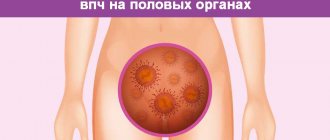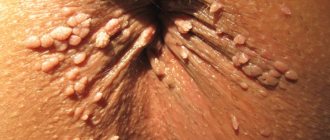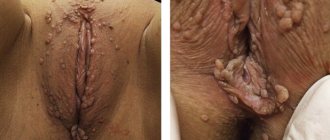Gynecologists classify intimate condylomas as sexually transmitted diseases, as well as through household contact. A woman can become infected with condylomas through sexual intercourse in the vagina, rectum, or, less commonly, through oral sex.
An ordinary condom often does not become an insurmountable barrier for them. Self-propagation of genital warts is possible with the emergence of new foci outside the zone of primary formation.
Vertical transmission of the virus occurs in 50-70% of children born to infected mothers.
Treatment of a virus that forms rashes and tumors in intimate places is an important measure to protect the health of one’s own and those around you. No one is immune from infection, which can be transmitted through household means and not show its symptoms for a long time.
Compliance with hygiene rules and other precautions will help avoid the formation of condylomas, which act as a signal of infection with the human papillomavirus.
What does genital papilloma look like?
It is a mushroom-shaped formation, based on a stalk and a wider area adjacent to it. The main causative agent of this infectious disease is the human papillomavirus (HPV), which is transmitted to a healthy body through any contact with the mucous membrane of an infected person.
The infection has a long incubation period. Under unfavorable conditions for virus reproduction, latent existence can last up to several decades.
When the granule is activated, rapid cell replication occurs, resulting in the formation of a nipple-like growth. Its color may differ from the color of the surrounding skin or mucous membrane.
The size of vulvar condyloma varies greatly and can reach 15 cm in length. The forms of genital rashes also differ significantly.
They are divided by type:
- Pointed.
- In the form of spots.
- In the form of papules.
- Bowenoid papulosis and Bowen's disease.
- Giant Buschke-Levenstein condyloma.
- In the form of neoplasia.
Genital warts look like flesh-pink bubbles that are attached to the skin with a thin stalk. As a result, cone-shaped processes are formed. Typically each of them grows to 1–3 mm in length.
Condylomas lata have an extensive stalk and are a sign of secondary syphilis. The lesion in the form of a spot is gray-white, pink and brown in color and is not recognizable to the touch. Papules are warts tied into nodules. They are more rounded and smooth.
Bowenoid papulosis is a consequence of the proliferation of wart nodules and spots. Characterized by a velvety, moist surface layer.
On mucous membranes, formations acquire red and brown shades, and on the skin - gray, brown or even black.
Giant Buschke-Levenstein condyloma is formed as a result of the fusion of many viral growths. Their cells can affect the entire surface of the genitals and nearby tissues. In this case, the disease progresses to the stage of squamous cell carcinoma.
Neoplasia is otherwise called a tumor. The tumor appears as a result of mutation of the virus genes. The accumulation of condylomas forms a large surface of the affected area under the influence of accelerated tissue growth.
Important! All types of genital warts are viral formations and require removal to avoid the development of malignant tumors. If the immune system is weakened, the disease may reappear.
Risk factors
Infection with the papilloma virus most often occurs through sexual contact with an infected person. All types of unprotected sex are dangerous - vaginal, anal, oral. Due to the small size of the virus, a condom does not provide 100% protection against infection. Therefore, people who are promiscuous have a particularly high risk of infection.
Some types of HPV can be transmitted even through simple contact of mucous membranes. Contact and household transmission of the virus is less common.
In total, medicine knows more than 100 types of HPV. HPV strains 6 and 11 can provoke the development of genital warts. The presence of these pathogens in the body before the appearance of skin growths is almost impossible to notice. In such a latent state, the infection can exist until provoking factors arise.
The activation of HPV and the formation of condylomas can be caused by:
- infection with another sexually transmitted infection (chlamydia, herpes virus, Trichomonas, etc.);
- weakened immunity, including immunodeficiency;
- vitamin deficiency, malnutrition;
- frequent stress, tension;
- pregnancy;
- undergoing surgical operations.
How common are they?
It is difficult to estimate the extent of HPV spread. In most cases, the symptoms of infection are hidden, and patients seek help if condylomas appear during the active phase of virus replication.
As a result of a study conducted by American scientists, data were published on the presence of HPV in 74% of the US population.
Among volunteers aged 15 to 49, only one in four Americans was not infected. In Russia, every third person is a carrier of the virus. This confirms the fact that people are illiterate and do not know about such a disease, continuing to spread it secretly.
Based on this, there is an assumption that anyone who has ever had sexual intercourse can be infected. In the United States, papillomavirus is the second most expensive diagnosis and treatment after AIDS.
Natural immunity copes with infection within 2 years in 90% of cases. According to statistics, the appearance of genital warts occurs in only 1% of the sexually active population.
Methods for removing genital growths
How to remove condylomas using modern techniques:
- diathermocoagulation - cauterization of condylomas in intimate places is carried out with an electric knife, damaged tissues heal within 7 days;
- laser therapy - the laser affects the formation, evaporates the pointed processes and leaves a dry crust;
- cryodestruction - liquid nitrogen is used to cauterize tumors (the method has a drawback - skin pigmentation);
- chemical burning - the use of special preparations;
- radiocoagulation - removal is carried out with high-frequency painless radio waves.
Reviews from patients claim that among the listed methods there are no ideal or perfect ones. Each has contraindications and specific uses, so the doctor prescribes a specific method, taking into account the patient’s physiological parameters.
| Procedure | pros | Contraindications |
| Diathermocoagulation | Simplicity, safety and accessibility | Pregnancy, cancer, inflammation in the body |
| Laser removal | No pain and blood, sterility, no side effects and long rehabilitation | Herpes, diabetes mellitus, exacerbation of chronic diseases, acute respiratory viral infections and influenza, blood clotting disorders |
| Cryodestruction | Does not cause severe pain and does not leave scars | Inflammatory process, dysplasia, endometriosis, infectious diseases |
| Radiocoagulation | Noticeable effect after the first procedure, painless, suitable for large formations | Herpes, purulent skin lesions, elevated body temperature, uterine bleeding, diabetes, presence of a pacemaker |
As for how to get rid of condylomas at home, do not try to self-medicate, as this is painful and there is a possibility of severe bleeding, purulent wounds, and other complications. You should strictly follow your doctor's recommendations. Folk remedies are concomitant therapy, not the main one.
Where do growths most often appear?
The practice of treating condylomas provides the following statistics on the formation of condylomas:
Among women:
- Cervix.
- Anal area.
- Vaginal mucosa.
- At the edge of the urethra.
- Upper and lower labia.
- Pubis and lower abdomen.
- Oral cavity and lips.
For men:
- Head of the penis.
- Scrotum.
- Anal area.
- Urethral area.
- Pubes and stomach.
- Mouth and larynx.
Individual condylomas on the pubis, scrotum, and labia do not cause pain, but only make their appearance unaesthetic. Others, on the contrary, can not only cause a lot of inconvenience, but also cause severe itching.
Growths in the anus and urethra can cause infection through ulcers and cracks. The vaginal and penile areas often bleed during sexual intercourse and emit a rotting odor.
Localization of condylomas in men
In men, genital warts appear in the following places:
- glans penis;
- surface of the inner layer of the foreskin;
- coronal sulcus;
- near the external opening of the urethra;
- in the perianal zone (near the anus);
- crotch area.
The growths can be single or multiple. They don't hurt or itch. Other unpleasant symptoms appear only when tumors are injured. In this case, the growths may bleed, hurt, and cause other discomfort.
The danger of papillomas on the genitals
Papillomavirus is not dangerous to the body and can be cured by the immune system. However, growths (papillomas, condylomas) of some strains modify their DNA, as a result of which the tumor becomes malignant. The risk of complications is high.
With poor nutrition, poor lifestyle, chronic diseases and stress, tumors can develop into cancer. Currently, the most common type is cervical cancer in women and penile cancer in men.
The presence of oncopapillomovirus is detected in the laboratory. Externally, the development of cancer is indicated by the proliferation of condylomas on the skin and mucous membranes.
Important! Papilloma cancer is well treated in the initial phases. If changes in the structure of condylomas are detected, you should contact a specialist.
Cauterization of intimate tumors
Cauterization is the most popular method of removing skin tumors. It is only important to choose a product based on a sufficiently strong acid. The drugs Solcoderm and Trichloroacetic acid are in demand. Thanks to their action, the proteins of condylomatous eruptions are denatured, the formation receives a chemical burn and evaporates. But you need to remember to protect the surrounding healthy tissues, so it is better to lubricate them with Vaseline. Only a doctor should cauterize with such means, as there is a high probability of getting scars.
Other methods of cauterization
There are other drugs that can cauterize tumors. Regular iodine is very popular. But there is a high probability of side effects after such an operation in the form of burns, iodine vapor poisoning and other manifestations. Therefore, it is better not to use it yourself. The drugs Wartner and Cryopharma also have a good effect. External products Collomak, Dermavit, Podophyllin, Ineferon, Condilin, Superchistotel and others have also proven themselves.
Among the unmentioned folk remedies, fir oil, laundry soap, lapis pencil, and potato juice are also widely popular.
Diagnostics
To detect HPV, a blood test is performed for antibodies in case of latent disease. The appointment begins with a clinical examination of the patient. If condylomas are detected, a gynecological examination and cervical smear or urethroscopy are prescribed.
Sometimes the help of a cytologist is necessary to conduct a PAP-smear test of the cervical mucosa. It is able to detect changes in the structures of low-risk oncoviruses.
Colposcopy and biopsy can determine the stage of infection and the risk of developing cancer. Histological examination based on biomaterials determines pathology with an accuracy of up to 98%.
The final stage is HPV typing if it is present. The latest development is the digene test.
It fully characterizes the virus, starting with typing, ending with determining the degree of risk of cancer and concentration in tissues. If a condyloma is present, the patient undergoes a shortened list of examination methods, the main purpose of which is to recognize the strain and classify the risk.
Intimate condylomas
Having penetrated the body, human papillomaviruses penetrate the basal layer of the epithelium, especially in the zone of transition of stratified squamous epithelium to columnar epithelium. In a cell, HPV can exist in two forms - outside the cell’s chromosomes or integrated into the genome. Regardless of its location in the cell, the virus will be detected when the smear is tested for PCR. Being in a cell outside the chromosomes, the virus can either not cause clinical changes (latent, hidden course), or lead to increased reproduction of unchanged (!) cells and clinically manifest in the form of warts or papillomas, for example, in the same intimate places.
Another variant of virus behavior is integration into the cell genome. In this case, it either leads to the development of neoplasia (grade 1-3 dysplasia), which ultimately becomes the cause of the development of carcinoma (malignant process - invasive cancer).
Hidden form
A less common variant of the clinical course of intimate condylomas in women and girls. Latent course of human papillomavirus infection without any changes in the skin or other manifestations, i.e. in this case, visible growths of genital warts in the intimate area or any other area of the body are not always observed. At the same time, the virus behaves “autonomously”, without interfering with the life activity of healthy human cells (there are types of papillomaviruses that do not manifest themselves in the human body throughout his entire life).
Active form
In this form, the body reacts to its presence in the cells and makes attempts to “limit” the further spread of the papillomavirus. This is achieved due to the compensatory proliferation of cells in the basal layer of the skin, resulting in the creation of a kind of “sarcophagus” of cells. As you probably guessed, this formation is called a “genital wart” or “intimate condyloma.” In this case, the virus integrates with the genome of human cells, as a result of which they are modified, which leads to dysplasia of the affected tissue area, or even cancer (the most common location of this process is the cervix, provoked by HPV types 16 and 18). A woman can be infected with several types of HPV at the same time.
As a rule, from the moment of infection to the appearance of papilloma (whether it is a wart or genital wart in the intimate area) time passes from several weeks to 9-10 months, and until the appearance of cervical or rectal cancer - from 5 to 15 years, depending on the type of HPV , its concentration (viral load) and, of course, the state of the human immune system. The relevance of condylomas in women is also due to the fact that highly oncogenic types of the virus increase the risk of developing precancerous diseases of the vulva and vagina by 60 times. Removal of condylomas in a clinic by a gynecologist (not self-medication at home!) is the main way to prevent this complication!
Questions - answers
1. WHERE CONDYLOMA GROWS. In women, they appear most often on the external genitalia in the area of the labia minora, less often on the labia majora, often in the vagina, on the cervix, in the urethra, perineum and near the anus. They are much less common on the clitoris, mouth, throat and anal canal. In masturbating girls or virgins who practice sexual games “without penetration” into the vagina, a gynecological examination can often reveal papillomatosis of the vestibule and hymen. See photos of condylomas in women.
2. CAN CONDYLOMAS GO AWAY BY THEMSELVES AND DISAPPEAR? At a young age, the immune system works very well, there are no chronic diseases, so condyloma in an intimate place can either suddenly appear or suddenly disappear. Especially if it is caused by non-oncogenic types of HPV and in a low titer (see quantitative analysis for condylomas in the table below).
3. WHEN ARE INTIMATE CONDYLOMAS CONtagious? If HPV enters a healthy body with good immunity, it may not appear clinically for some time. Sometimes this period lasts months and years (the incubation period can last from several weeks to 2-3 years). If the HPV that enters the human body is not an oncogenic type, it does not pose any threat to the carrier itself and is not transmitted to others. But as soon as an exacerbation begins, and genital warts or papillomas grow in the intimate area or on the skin, it begins to be transmitted to the contactee upon any contact.
4. CONDYLOMAS WITHOUT HPV - DOES IT HAPPEN? Are genital warts possible without HPV? In women and men, these formations are a consequence of the human papillomavirus entering the body. However, when asking questions to a gynecologist or on medical forums, many people discuss a negative HPV test, but there are papillomas or condylomas. Let’s clarify this situation and give a few reasons why this could be:
- Violation of the rules for collecting material for analysis;
- The NGE laboratory conducts this range of research;
- Failures in the technological process of performing the analysis;
- More than 100 types of HPV are known to medicine, and many of them can cause various formations on the body. As a rule, laboratories diagnose only 14 main, clinically significant, types of high oncogenic risk, for example, 6, 11, 16, 18, 31, 33, 56, etc. Therefore, negative HPV in the presence of condylomas indicates that your disease is caused by non-oncogenic types of the virus. This is prognostically more favorable (of course, if paragraphs 1-3 are irrelevant).
5. IS IT POSSIBLE TO COMPLETELY CURE HPV IN WOMEN? There are currently no treatments for condylomas with reliably proven effectiveness. Systemic therapy for HPV infection has not been developed and is only necessary in the case of complicated HPV infection (papillomas, condylomas, dysplasia, erosion), or long-term, recurrent HPV infection, especially when high cancer risk types of the virus are identified. For example, in the presence of HPV and condylomas, it is necessary to remove formations as a source of infection and carry out complex antiviral therapy.
As for the use of immunomodulators, their use should be balanced, reasoned and after a blood test for immune status. Afterwards, dynamic monitoring should be carried out - regular HPV Digen test, PAP test (cervical oncocytology), colposcopy and vulvoscopy to identify possible foci of relapse of genital papillomatosis. Consider getting vaccinated against HPV. The Gardasil vaccine, of course, will not protect against the type that already exists, but it will help prevent infection with other dangerous types of HPV.
6. HOW TO REMOVE CONDILOMAS AT HOME? If you really want to, you can find tips on how to remove genital warts at home. For example, on the Internet there are tips on how to cauterize intimate warts with acid, lubricate them with ointments and creams, herbal recipes from “grandmother..., grandfather...” and other all-scientific and sometimes downright harmful recommendations. I will quote one patient of our gynecology, who tried to get rid of papillomas between her legs on her own, received a rather strong side effect from the so-called “folk recipes” and came to the conclusion that “... a woman has only one pussy and she must be treated with care, with trepidation, and trust her health, well-being and appearance only to medical professionals!”
7. CAN CLEANING THE BODY FROM PARASITES HELP? Attempts to cleanse the body of papillomas in the intimate area instead of removing them, as well as to expel other parasites (germs, worms, viruses, including HPV) with various microwaves, UHF currents, exposure to resonant frequencies and other similar undertakings - shamanism, quackery or It's just pure fraud. By expelling uninvited intestinal inhabitants with a pharmaceutical drug, you will certainly be doing your body a favor, but you will not get rid of HPV and genital warts from your intimate area!
8. EROSION AND CONDYLOMA In gynecology, cervical erosion is a collective concept that simply describes certain changes in the cervical mucosa, but is not a diagnosis as such. Accordingly, not all erosion requires treatment. In order to determine what exactly led to its formation, it is necessary to do a cytological examination of the scraping and an extended colposcopy. If you just have ectopia (false erosion associated with hormonal characteristics in the period up to 22 - 25 years, in women who have not given birth), it is uncomplicated and small in size, then it does not require treatment. If you are diagnosed not with ectopia, but with any transformation of the mucous membrane, especially in the presence of intimate warts or papillomas, you need to be examined for HPV types (Digen test) and hidden infections. The next step may be a biopsy of the cervix (taking a section of tissue). Histological examination allows us to understand the nature of changes in the cervix, confirm or refute the presence of flat “cervical” warts, which will give the correct final diagnosis and help the doctor choose the optimal method of treatment or cauterization of condylomas.
Treatment of genital papillomas
Based on compliance with 3 steps recommended by the doctor:
- Removing the build-up.
- Taking antiviral drugs.
- Strengthening the immune system.
The process of removing condylomas is carried out in different ways using local anesthetics:
- Surgical scalpel.
- Laser coagulation.
- Radio wave method and ultrasound.
- Cryodestruction.
- Electrocoagulation.
- Diathermocoagulation.
Surgical removal is allowed if the condyloma is large. The skin area is then tightened with medical threads. Dissection of growths with a laser leaves almost no wounds and occurs without pain.
The radio wave method involves burning out the condyloma with the Surgitron apparatus. Detachment occurs under the influence of high-frequency waves. The cost of the procedure guarantees the absence of complications. Ultrasound is also the safest method.
Cryotherapy uses liquid nitrogen as its active ingredient. The frozen condyloma falls off, leaving a small wound. Electro- and diathermocoagulation burn out formations, but leave scars on the skin. These methods are not recommended for nulliparous girls.
Treatment of condylomas and human papillomavirus
Treatment of condylomas is prescribed by a doctor individually. There are several ways to treat condylomas:
- Laser removal. It is performed under anesthesia.
- Electrocoagulation – removal of condylomas using high temperature. It is performed under anesthesia.
- Cryodestruction with liquid nitrogen - removal of condylomas using low temperature. No anesthesia is required and no scars are left.
- Radio wave removal of condylomas.
- Treatment with immunostimulating drugs.
How to get rid of, remove growth at home?
At home, you can use methods that promote the death of condylomas. Safe are:
- Iodine.
- Celandine.
- Garlic.
- Onion.
- Honey and propolis.
- Apple vinegar.
- Egg white.
Iodine effectively cauterizes condylomas with repeated use. Over time, they dry out and fall off. In this case, only the affected surface is wetted. The course is repeated 2 times a day. Antiseptics are used together with iodine to heal the resulting wound.
Celandine in the form of a tincture or freshly squeezed helps to neutralize the vital functions of the growth. The condyloma dies and falls off along with the stem. The composition is applied 3 times a day.
Garlic and onion juice are destructive to pathogenic microorganisms; they contain a lot of tannins and antiseptic substances. Papillomas disappear quickly and painlessly. When mixed with vinegar, the compresses are of the highest quality.
A compress of aloe vera juice, honey and plantain leaves is considered the most effective remedy. It is kept for 15 minutes 2 times a day. Propolis can simply be placed under a patch to dry the skin. After 14 days the desired result will appear.
Apple cider vinegar is applied at night; with proper use, condyloma disappears in a week. Boiled egg white helps reduce the size of condylomas. In the fight against removing external manifestations, HPV is not suitable.
Diagnosis of the disease
Before starting treatment for condylomas, it is necessary to diagnose the disease. If the formations are localized on the external genitalia, they are detected independently. Regarding internal placement, the disease can only be seen by a doctor. To determine the strain of papillomavirus, a blood test is performed.
It is not recommended to independently diagnose condylomas at home, since they can be confused with similar diseases that accompany an exacerbation of HPV - syphilis, molluscum contagiosum, and other pathologies. Diagnostic procedures are recommended to be carried out by a dermatologist, gynecologist (urologist), or immunologist. Doctors will help you determine the correct diagnosis and tell you how to get rid of condylomas at home using modern hospital methods.
Removal in the clinic
Patients are pre-diagnosed to determine the type of virus and its origin. For this purpose, various methods of laboratory analysis of biomaterial are used. Women are additionally prescribed colposcopy and cytological examination.
After receiving the test results, therapy is prescribed depending on the complexity of the disease. Today, medicine is replete with a variety of physical and surgical methods for removing condylomas. Most often they resort to the use of laser, ultrasound and more conservative techniques.
Everything happens on an outpatient basis with the use of painkillers. Along with this, a course of antiviral and immune drugs is prescribed. In case of relapse, repeated removal is performed. Treatment methods are often combined to achieve the desired result.
Removal of genital warts
Did the gynecologist find condylomas? They should be removed as soon as possible. Cauterization of genital warts in women is carried out by a doctor after an examination. Preliminary diagnosis (determining the genotype of the virus and its quantity, extended colposcopy of the vulva) before treatment allows you to accurately determine the cause of the process, the extent of the lesions, and their nature.
The procedure for removing condylomas/papillomas is necessary, since they can either spread further throughout the body or be injured in various ways - during sexual intercourse, clothing, during hair removal or shaving - and degenerate into malignant neoplasms. It is strictly not recommended to carry out such manipulations with formations at home on your own using folk remedies.
Diagnostics
- Gynecological examination;
- Extended colposcopy;
- Biopsy (if indicated);
- Tests for “hidden infections”;
- HPV tests with genotyping;
- Blood tests (RV, HIV, hepatitis B, C).
Tests for condylomas
1. Identification of human papillomaviruses, their type and quantity
| Types of analyzes | Price | |
| HPV types 6/11 | yes / no | 650 |
| HPV types 16/18 | yes / no | 650 |
| Common HPV (16, 18, 31, 33, 35, 39, 45, 51, 52, 56, 58, 59, 68) | yes / no | 1 550 |
| HPV genotype (16, 18, 31, 33, 35, 39, 45, 51, 52, 56, 58, 59) | type definition | 2 350 |
| Number of HPV (types 16, 18, 31, 33, 35, 39, 45, 51, 52, 56, 58, 59, 68) | quantity | 2 950 |
| Number of HPV (16, 18) | quantity | 950 |
2. Comprehensive HPV test (liquid Digen test)
Digen test | Price | |
| HPV types 6/11 | qualitative | 6 500 |
| HPV genotyping (16, 18, 31, 33, 35, 39, 45, 51, 52, 56, 58, 59) | type definition | |
| Number of HPV (16, 18, 31, 33, 35, 39, 45, 51, 52, 56, 58, 59, 68) | quantity | |
Methods for removing condylomas
Based on the data obtained during the examination and examination, our gynecologist individually selects the optimal method for eliminating the disease for each patient. When treating condylomas, clinic specialists use various methods, depending on the location, number and size of the formations. An individual approach allows us to achieve the best results in eliminating this problem in women and teenagers.
Radio wave removal of condylomas |
In our clinic in Moscow, radio wave removal of condylomas is carried out using the Fotek / Surgitron device. The smaller the tumor and the earlier the procedure is performed, the higher the chance of avoiding the spread of the virus to neighboring tissues. Unlike “cauterization” of intimate condylomas with an electrocoagulator, liquid nitrogen or “evaporation” with a laser, Surgitron “removes” the thinnest layer of altered skin or genital mucosa without causing burns to surrounding healthy tissue.
The procedure performed using the radio wave method is accurate and painless (with adequate anesthesia, of course) and in the long term does not leave any scars because there is no direct contact between the electrode and the tissue. When removing genital warts in particularly sensitive intimate areas (clitoris, urethra, labia), we perform local anesthesia - EMLA cream or submucosal injection of a modern imported anesthetic.
Chemical method |
Chemical methods are used mainly in cases of single, few formations of the mucous membrane of the external genitalia. The drug Solcoderm or Solkovagin (made in Switzerland), a mixture of organic and inorganic acids, is selected depending on the location of the formation: on the skin surface or on the mucous membrane. In our clinic, this method of eliminating papillomatous formations of the external genitalia has been successfully used for more than 20 years.
Where to remove condylomas
Removal of condylomas and papillomas in intimate places in women (“cauterization”) is a necessary, safe and virtually painless procedure. In Moscow, cauterization can be performed in our clinic on Kutuzovsky Prospekt 33. Condylomas are removed by qualified gynecologists (for patients at a young age - a pediatric gynecologist), under modern local anesthesia. After a preliminary consultation, examination and tests, the clinic will offer you the most effective method of treating genital warts. The best specialists and the use of the most modern equipment allow us to provide you with the maximum cosmetic effect - after 2-4 weeks there will be no trace left of the sessions!
Removal of condylomas in Moscow - quickly, painlessly and effectively! • Make an appointment with a gynecologist, • Discuss the problem with your doctor, • Do cauterization.
☏ +7(495)761-1085 ☏ WhatsApp ☏ Viber
Drugs for the treatment of HPV
Treatment of HPV is carried out comprehensively using:
- antiviral drugs locally and by injection;
- medicines with chemical compounds;
- immunomodulators and vitamins;
- antibiotics;
- cytostatics.
Often, patients require the help of several doctors, usually a gynecologist, venereologist, or dermatologist. Antiviral vaccination is considered a more effective method compared to tablets, suppositories and ointments.
However, among the antiviral drugs, isoprinosine (analogs of isoprinosine) and groprinosin in tablet form are distinguished. They fight the virus and stimulate the immune system, as a result of which the external manifestations of HPV disappear.
Panavir (suppositories, injections) and ointments based on acyclovir are widely used. They affect the skin without complications.
Chemical compositions are designed to burn out papilloma and do not eliminate the problem of the presence of the virus. Applied topically. Condilin and feresol in the form of solutions dry the affected area well, the deficiency is removed only externally.
Immunomodulatory drugs help suppress the growth of tumors and prevent relapse. Neovir, Viferon and Likopid are used most often. Their action also prevents the development of oncoviruses.
Antibiotics are prescribed in case of inflammation and in the presence of sexually transmitted diseases. Their wide spectrum of action negatively affects the microflora of the gastrointestinal tract. In addition to them, formulations with bifidobacteria are taken.
Cytostatics are prescribed when precancerous condylomas are detected. The most aggressive drugs are 5-fluorouracil, podophyllin, bleomycin and podophyllotoxin. All of them are aimed at destroying the development of cancer cells.
The need to remove growths
Removal is carried out using surgical and conservative approaches. Various alternative medicines for condylomas are often used. Conservative treatment involves taking drugs that fight the virus, restoring immunity. They do not destroy growths. They are removed separately. Such genital formations contribute to the development of genital cancer. If they are accidentally damaged, severe bleeding will occur.
Sakania Luiza Ruslanovna
Dermatovenerologist, cosmetologist, trichologist
Ask a Question
The presence of growths on the genitals significantly worsens a person’s sex life. Insecurity and a feeling of inferiority appear. There are more problems with finding a life partner. Removal of condylomas is a necessary procedure.











